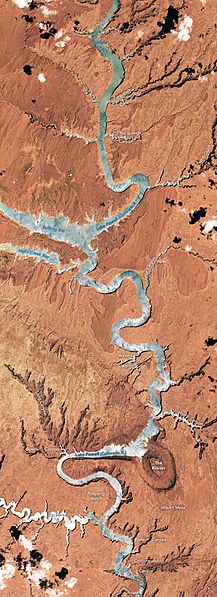Image: Lake Powell mosaic from ISS

Description: When John Wesley Powell explored the Colorado River in 1869, he made the first thorough survey of one of the last blank spots on the map. The expedition began in May at Green River, Wyoming, and ended three months later at the confluence of the Colorado and Virgin Rivers in present-day Nevada. About two months into their journey, the nine men of the expedition found themselves in Glen Canyon. As the men traveled along the serpentine river channel, they encountered what Powell later described in Canyons of Colorado as a “curious ensemble of wonderful features.” While the walls were not nearly as high in Glen Canyon as they were downstream in Marble Canyon or Grand Canyon, the explorers encountered a labyrinth of overhanging cliffs, hanging gardens, sweeping river bends, and natural arches set amidst a backdrop of colorful buttes and mesas. “Past these towering monuments, past these mounded billows of orange sandstone, past these oak-set glens, past these fern-decked alcoves, past these mural curves, we glide hour after hour, stopping now and then, as our attention is arrested by some new wonder,” wrote Powell. From above, the view of Glen Canyon is equally arresting. In 2016, an astronaut aboard the International Space Station took several photographs that were combined to make this long mosaic. The water has an unnatural shade of blue because of sunglint, an optical phenomenon that occurs when sunlight reflects off the surface of water at the same angle that a camera views it. One of the most prominent features in this stretch of the Colorado is the Rincon, an entrenched and abandoned meander, or loop, in the river. Geologists believe it formed several thousand years ago when the river cut straight across the ends of the loop and shortened its course by 6 miles (10 kilometers). The modern view is rather different than what members of Powell’s expedition likely would have seen. When the Glen Canyon Dam was finished in 1963, water levels began a slow rise, submerging many of the geological features—including an acoustically remarkable side canyon called Music Temple—that Powell found so compelling. Due to drought and the presence of porous rock in this area, it a took a full 17 years for the reservoir (Lake Powell) to reach its maximum capacity.
Title: Lake Powell mosaic from ISS
Credit: https://earthobservatory.nasa.gov/images/88922/a-curious-ensemble-of-wonderful-features?src=on-this-day
Author: NASA ISS Crew Earth Observations Facility
Permission: Public domainPublic domainfalsefalse This file is in the public domain in the United States because it was solely created by NASA. NASA copyright policy states that "NASA material is not protected by copyright unless noted". (See Template:PD-USGov, NASA copyright policy page or JPL Image Use Policy.) Warnings: Use of NASA logos, insignia and emblems is restricted per U.S. law 14 CFR 1221. The NASA website hosts a large number of images from the Soviet/Russian space agency, and other non-American space agencies. These are not necessarily in the public domain. Materials based on Hubble Space Telescope data may be copyrighted if they are not explicitly produced by the STScI.[1] See also Template:PD-Hubble and Template:Cc-Hubble. The SOHO (ESA & NASA) joint project implies that all materials created by its probe are copyrighted and require permission for commercial non-educational use. [2] Images featured on the Astronomy Picture of the Day (APOD) web site may be copyrighted. [3] The National Space Science Data Center (NSSDC) site has been known to host copyrighted content. Its photo gallery FAQ states that all of the images in the photo gallery are in the public domain "Unless otherwise noted."
Usage Terms: Public domain
License: Public domain
Attribution Required?: No
Image usage
The following page links to this image:

